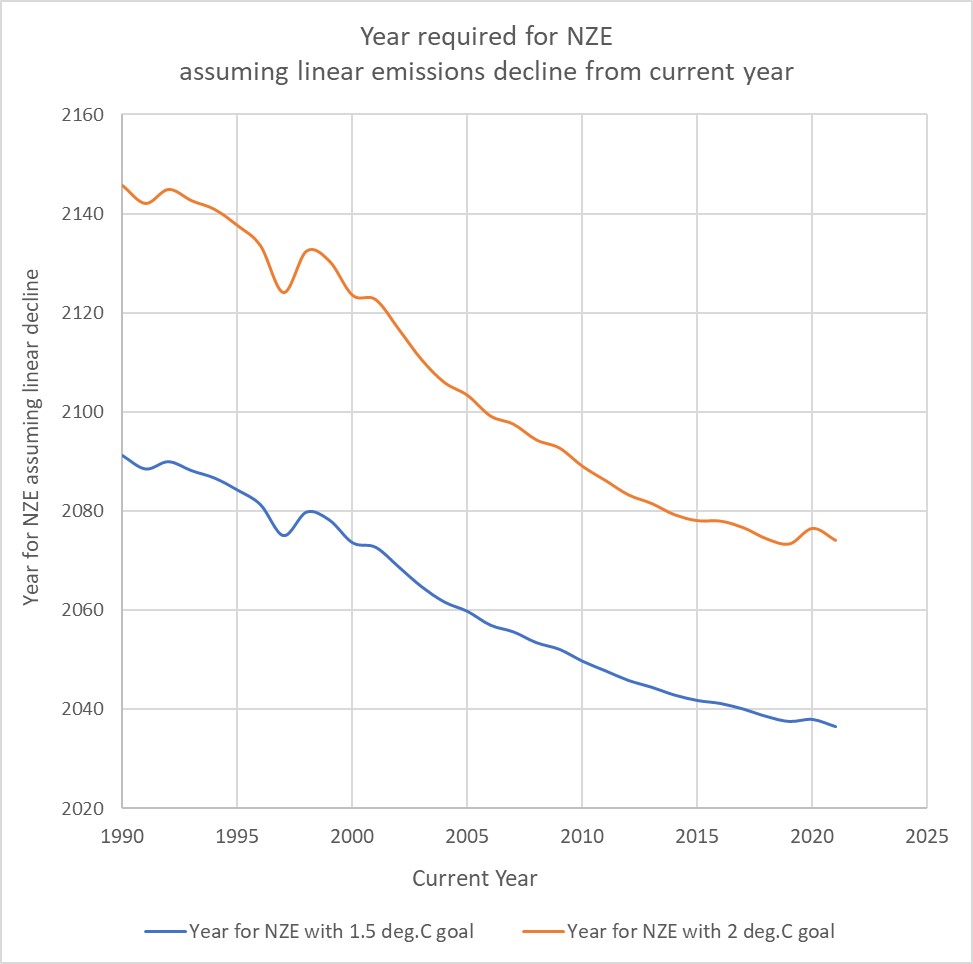
When I first started delving into the issue of climate change about 20 years ago, the clarion call of the day was to reduce emissions by 50% by 2050. Today, as we all know, the call is for net-zero emissions by 2050. Last week we also heard again from the Intergovernmental Panel on Climate Change (IPCC) with the release of the first part of the 6th Assessment Report (AR6), which the United Nations Secretary General called a ‘code-red for humanity’. But both the call in 2001 and again in 2021 are entirely consistent. It’s not the climate science that has changed, just the carbon maths associated with it.
As the IPCC clearly state in Part D of the Summary for Policymakers of AR6-WG I;
- This Report reaffirms with high confidence the AR5 finding that there is a near-linear relationship between cumulative anthropogenic CO2 emissions and the global warming they cause. Each 1000 GtCO2 of cumulative CO2 emissions is assessed to likely cause a 0.27°C to 0.63°C increase in global surface temperature with a best estimate of 0.45°C. This is a narrower range compared to AR5 and SR1.5. This quantity is referred to as the transient climate response to cumulative CO2 emissions (TCRE). This relationship implies that reaching net zero anthropogenic CO2 emissions is a requirement to stabilize human-induced global temperature increase at any level, but that limiting global temperature increase to a specific level would imply limiting cumulative CO2 emissions to within a carbon budget.
While the biggest difference between now and 2001 is the shift in the goal from below 2°C to 1.5°C which in turn has contributed to the change in required emissions trajectory, this is not enough to explain the shift in the required outcome by 2050. That change is more a function of the cumulative carbon math associated with any level of warming.
To limit the temperature rise to 1.5°C, the notional carbon budget based on the above best estimate of TCRE is 1.5/0.45*1000 = 3330 Gt CO2 and for 2°C it is 4440 Gt. This is effectively targeting the central estimate in a range and is a calculation you might do before emissions start. However, we already know from IPCC AR6 that cumulative emissions of 2390 Gt correspond to a 1.07°C temperature rise in 2010-2019 vs. 1850-1900. They also indicate that the remaining carbon budget from 1.1.2020 for 1.5°C is 400 Gt and 2°C is 700 Gt for a 67% likelihood, which implies an overall carbon budget of 2790 Gt for 1.5°C and 3090 for 2°C with a good degree of certainty.
In the following calculations and accompanying charts I will work on the basis of a simple linear reduction in emissions to net-zero from a particular point in time to calculate the overall cumulative emissions. Returning to 2001, the annual CO2 emissions (from energy, cement and land use) were approximately 30 Gt, the cumulative emissions from 1850 at that time were about 1700 Gt and a linear reduction pathway from 2001 for 2790 Gt final cumulative emissions (1.5°C) means net-zero emissions in about 2073. This is illustrated in the chart below.

As noted for 2001, cumulative carbon dioxide emissions since 1850 were at 1715 Gt (Source: Our World in Data), which means net-zero emissions in 2073 for 1.5°C and 2123 for 2°C. Back in 2001 the focus was more on 2°C, so targeting well below 2°C, to completely avoid the 2°C threshold, would mean net-zero emissions around 2100 and therefore a 50% reduction in emissions by 2050 assuming a linear decline.
But twenty years later the story is very different. At the time of the IPCC Special report on 1.5°C cumulative carbon dioxide emissions had reached 2300 Gt, so a linear reduction to net-zero had a target date of 2040. For 2°C it was 2077. In fact the IPCC opted for scenarios with a steeper early reduction pathway, and therefore targeted 2050 for net-zero emissions, but that means a very steep early reduction of over 50% by 2030 to balance the longer tail to 2050. With twenty further years of rising emissions, a considerable portion of the 2001 carbon budget had been consumed and therefore the date for net-zero emissions had moved forward in time dramatically.
In fact, for each year that emissions don’t reduce, the requirement for net-zero emissions comes towards us by a year, effectively narrowing the gap for action by two years. The IPCC Special Report on 1.5°C was baselined from 1.1.2018, so another four years has passed (or will soon pass). Even the recent IPCC AR6 is two years out of date now in terms of its carbon budget baseline. This rapidly shifting picture is shown below. In 2015 the target year for 1.5°C is shown to be 2042, a gap of 27 years, but by 2019 the target year is 2038, a gap of only 19 years.

Should carbon dioxide emissions remain at 40 Gt (below the pre-COVID high) for the coming few years, the available carbon budget for 1.5°C is rapidly consumed, as illustrated in the chart below. By 2025 net-zero emissions would be required by about 2033 and by 2029 net-zero emissions would be required before 2030, in other words the available carbon budget will have been consumed.

All the above presupposes that emissions cannot go below zero in the future, thereby drawing carbon dioxide out of the atmosphere and eventually correcting any overshoot of the carbon budget and its associated temperature goal. But negative emissions are a possibility, through the implementation of large scale air capture systems with geological storage (BECCS or DACCS) and enhancement of natural carbon uptake in the biosphere via programmes such as those that increase global forest cover and improve soil carbon management in agriculture.
Today, the carbon budget is still a rather arcane subject, well understood by a few but not widely appreciated in terms of relevance to managing surface temperature. That understanding will need to improve rapidly so policymakers can develop better mechanisms to manage it, also ensuring large scale deployment of atmospheric drawdown practices and technologies.

Average Rating